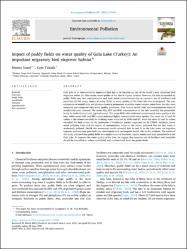| dc.contributor.author | Varol, Memet | |
| dc.date.accessioned | 2021-07-20T08:00:30Z | |
| dc.date.available | 2021-07-20T08:00:30Z | |
| dc.date.issued | 2021 | en_US |
| dc.identifier.citation | Varol, M., & Tokatlı, C. (2021). Impact of paddy fields on water quality of Gala Lake (Turkey): An important migratory bird stopover habitat. Environmental Pollution, 117640. | en_US |
| dc.identifier.issn | 0269-7491 | |
| dc.identifier.issn | 1873-6424 | |
| dc.identifier.uri | https://doi.org/10.1016/j.envpol.2021.117640 | |
| dc.identifier.uri | https://hdl.handle.net/20.500.12899/311 | |
| dc.description.abstract | Gala Lake is an internationally important lake due to its location on one of the world's most important bird migration routes. For this reason, water quality of the lake is of great concern. However, the lake surrounded by paddy fields may face eutrophication and toxic metal contamination due to excessive use of fertilizers and pesticides. In this study, impact of paddy fields on water quality of the Gala Lake was investigated. The concentrations of metal(loid)s and physico-chemical parameters in surface water samples taken from the lake were measured and compared with water quality guidelines. Also, human health risks and contamination status of metal(loid)s were assessed. The mean NO2, SRP and BOD concentrations in the lake exceeded the permissible levels for both salmonid and cyprinid waters. The mean BOD value indicated contaminated water quality in the lake, while mean COD and SRP values indicated lightly contaminated water quality. The mean As, Cr and Pb values in the winter exceeded the drinking water limits set by WHO and EC, while the mean Cr and Zn values exceeded the limit values for the protection of freshwater aquatic organisms set by USEPA. Similarly, heavy metal pollution index and the degree of contamination values in the winter indicated that the lake water is moderately polluted. Health risk assessment results revealed that As and Cr in the lake water via ingestion exposure pathway may pose both non-carcinogenic and carcinogenic health risks to the residents. The results of this study indicated that paddy fields are a major source of nutrients, organic matter and toxic metal(loid)s to the Gala Lake. To improve the water quality of the lake, we suggest that excessive use of fertilizers and pesticides should be controlled to reduce metal(loid) and nutrient loads from the paddy fields. | en_US |
| dc.language.iso | eng | en_US |
| dc.publisher | Elsevier | en_US |
| dc.relation.isversionof | 10.1016/j.envpol.2021.117640 | en_US |
| dc.rights | info:eu-repo/semantics/closedAccess | en_US |
| dc.subject | Gala Lake | en_US |
| dc.subject | Paddy fieldsmetal(loid)s | en_US |
| dc.subject | Nutrients | en_US |
| dc.subject | Agrochemicals | en_US |
| dc.subject | Risk assessment | en_US |
| dc.title | Impact of paddy fields on water quality of Gala Lake (Turkey): An important migratory bird stopover habitat | en_US |
| dc.type | article | en_US |
| dc.authorid | 0000-0001-6475-0570 | en_US |
| dc.department | MTÖ Üniversitesi, Doğanşehir Vahap Küçük Meslek Yüksekokulu, Su Ürünleri Bölümü | en_US |
| dc.contributor.institutionauthor | Varol, Memet | |
| dc.identifier.volume | 287 | en_US |
| dc.identifier.startpage | 1 | en_US |
| dc.identifier.endpage | 8 | en_US |
| dc.relation.journal | Environmental Pollution | en_US |
| dc.relation.publicationcategory | Makale - Uluslararası Hakemli Dergi - Kurum Öğretim Elemanı | en_US |


















